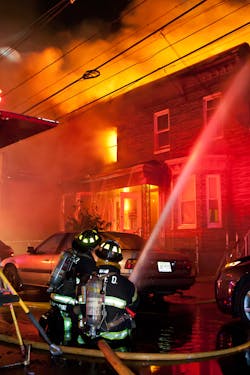We’ve all seen it: A deviant behavior is repeated, without catastrophic results, and eventually becomes the accepted social norm for the organization. This process is called the “normalization of deviance,” and it was defined in Diane Vaughan’s book The Challenger Launch Decision as, “The gradual process through which unacceptable practice or standards become acceptable.”(1) It’s easy to consider why Vaughan would have written about this concept in a book about the Challenger tragedy.
Looked at another way, we as humans take shortcuts while we are under time and pressure constraints. These shortcuts are usually referred to as “safety” shortcuts.
We will consider these ideas to better understand firefighter behavior as it pertains to the normalization of deviance and why the fire service must learn to recognize the “drift into failure” process—a process that builds slowly and ultimately leads us down a path toward firefighter injury and death.
Fire service “shortcuts”
It is important to understand that we as firefighters may be taking more shortcuts and risks to achieve the level of expectations that our organization and public has established for us. Shortcuts can include reduced staffing, lack of training, dwindling equipment, resources and funding. These shortcuts can and will most likely lead to frustrations throughout the entire organization and will often ensure a path toward complacency. It is important to understand that complacency is a symptom and not the cause of organizational or personal failure(s).(2) It takes more than a few sudden decisions by badly informed or unmotivated firefighters to push an organization into failure.
- John Dixon at Firehouse World 2016: John Dixon will be presenting "Normalization of Deviance—How to Overcome Complacency" at Firehouse World in San Diego, Jan. 31-Feb. 4. Find out more at FirehouseWorld.com.
Far too often we read about line-of-duty deaths (LODDs) and injuries. This frustrates me as a fire officer and educator. There are many contributing factors that lie within these reports. While I understand that we must learn from the information that is presented, it seems that they have become “boilerplate” reports. This seems to prove that the drift into failure is prevalent and that there is a need for corrective action. Following are examples of recurring causes listed within LODD reports.
Reduction of safety and staffing
This contributing factor is due in most part to the large contingency of departments that are experiencing a reduction in public funding. The reduction in staffing impacts our personal safety and the community’s safety at large. Reduced staffing is a warning sign of the drift into failure process. The “drift” stays under the radar until a serious injury or death occurs. When fire departments do not have the proper number of personnel to effectively mitigate the incident, the safety of all parties involved will suffer.
Command and control
The insufficient use of the incident command system and the lack of proper supervision by management both result in additional safety shortcuts. These shortcuts can be identified as failing to match the strategy and tactics to the incident at hand. We must collectively learn that there is no singular strategy that will fit into every one of our incident action plans. I fear many of us are still holding on to the antiquated mentality: “This is the way we have always done it, so why should we change?”
Communications
NIOSH reports usually focus on fireground communications, or the lack thereof. Were orders given but not received? Was vital fireground information not relayed? This may be true for the specific incident, but there must have also been a breakdown of communication that occurred within the organization prior to the incident. It is my hope that we can dig deeper into the complex system of overall communications, individually and organizationally. Doing so will help us avoid the drift into failure process.
Culture: personal and organizational
It is important to understand that culture is either by design or default. Deviant behavior and actions are a result of learning the norms, values and beliefs of the organization as a whole. We must properly indoctrinate our personnel to higher standards if we wish for the culture change to take hold.
It may be easy for investigators to analyze and report what went wrong by looking solely at the causes of the incident, especially when they already know the outcome. We must further investigate why the affected firefighters and organizations made the decisions that they did at the time. Doing so will demonstrate and explain why deviance differs from one organization to another.
Organizations and firefighters alike do not have a mindset for failure; we don’t go to work thinking, “Today is the day we will get caught in a collapse or fall through a roof.” Yes, bad outcomes happen and firefighting is an inherently dangerous job. But as Dr. Rich Gasaway says, we need to recognize the signs and symptoms in a timely manner to help prevent bad outcomes.(3) Situational awareness must occur on and off the fireground.
Drift into failure
Dr. Sydney Dekker explains that drift into failure is a slow and incremental process from which no organization is exempt. He further states that failure emerges opportunistically (not randomly) from inside the organization. We may not know what is happening around us because our behaviors are deemed acceptable at the time and because the drift is invisible. We tend to correct our course of actions due to an LODD or severe injury. This is why the fire service seems reactive at times.
Drift can be further defined as complacency and in some cases a loss of situational awareness. Either way, both will eventually lead to a catastrophic event that affects not only the organization but also the fire service as a whole.
Even well run organizations experience drift, yet they are not immune to its failure. Perhaps these organizations have not yet experienced a firefighter death or injury. This does not mean that deviance is absent from their organization.
In reality, these organizations may be experiencing false feedback. The deviant behaviors of individuals within the organization were accepted, either willingly or by default because nothing tragic happened as a consequence. The lack of a tragedy may have falsely communicated that no corrective action was necessary. Thus, the cycle will continue until a catastrophic failure eventually occurs.
The ABCs of complacency
Attitudes, behaviors and conditions (ABCs) are key signs to recognizing complacency. Fire service culture is driven by all three of these actions. If we are to correct the attitudes, behaviors and conditions, we must first start with taking a hard look at ourselves and how we individually contribute to these factors.
A positive attitude starts with us as individuals and impacts how we interact with others within the organization. If we choose to have a positive attitude, it will be contagious to the rest of the organization. Our behaviors match our attitudes in such a way that if we are in a negative frame of mind, our behaviors will become deviant, whether it was our intention or not. Nothing leads to a condition of complacency faster than a poor attitude.
The ABCs are interconnected and are a direct result of the drift. Another example of personal complacency includes the failure to check our SCBAs at the start of each shift. The complacent firefighter assumes that the firefighter who was on duty before him did their due diligence; therefore, he can drift away from his personal responsibility.
Another example is the use of seatbelts. The old-world cultural thinking is that we need to be quick with our response and wearing a seatbelt will slow us down. Dr. Burton Clark further states that our dysfunctional seatbelt culture is the root cause of firefighter deaths in apparatus accidents.(4) Culture drives behavior.
An example of organizational complacency includes not having proper emergency vehicle operating SOGs. The complacency lies within the assumption that every driver will operate the apparatus with due regard toward safety. Assumptions lead to decisions and, as aforementioned, it takes more than just one error in the decision-making process to cause a drift toward failure.
Battling complacency
Constant evaluation of organizational and personal standards is vital to ensuring that we avoid the drift toward failure process. In order to establish higher standards, we must strive for continuing education. Education is the best solution to preventing normalization of deviance. We must remain diligent in indoctrinating our recruits while looking to develop a higher caliber of recruit. This will be achieved through more aggressive and focused recruitment campaigns.
Once we become better at recruiting for character and training for skill, the fire service cultural transition will become the social norm for our organizations. It is far easier to prevent the normalization of deviance than it is to correct it! Rather than drifting, a corrective course will be set. Setting a formal mentoring process will also ensure that our efforts will continue on long after our tour of duty is over.
This process will need to be established and adopted from the top of the organization, continuing all the way down to the probationary firefighter. Those who are in leadership positions must realize that we all have the responsibility to break from the status quo and seek continuous improvement.
Within the fire service, we have been quite accustomed to change, for better or worse. Change is inevitable; however, growth is not.
Battling complacency will also need a refocusing on our fireground training. It may be that complacency is setting in due to a lack of relevant hands-on training evolutions. We must fight the urge of a safety-in-training paralysis and get more physical. Firefighters are primarily kinesthetic learners. Let us not forget the words of Ben Franklin, considered by many the founder of the American fire service: “Tell me and I forget, teach me and I may remember, involve me and I learn.” This quote still holds true today as it did hundreds of years ago.
Closing thoughts
Today’s fire service is strong. In the shadows, there are countless firefighters who are quietly learning and leading for the betterment of everyone. They are properly preparing themselves for their chance to step up and formally lead their organizations.
I encourage all of you to constantly seek improvement in all that you do. Yes, leadership is a decision, but more importantly, it is an action. There cannot be one without the other. We must fight complacency at all costs; our lives and those we lead are counting on it. What are you prepared to do to correct the normalization of deviance?
References
1. Vaughan, D. (1996) The Challenger Launch Decision. University of Chicago Press
2. Dekker, S. (2011) Drift into Failure - From Hunting Broken Components to Understanding Complex Systems. Ashgate Publishing
3. Gasaway, R. (2015) www.samatters.com
4. Clark, B. (2015) I Can’t Save You But I’ll Die Trying - The American Fire Culture. Premium Press America
About the Author

John Dixon
John Dixon is a career fire officer with the Teaneck (NJ) Fire Department and has more than 23 years in the fire service. He earned his fire officer (FO) credentials from the Center for Public Safety Excellence, Graduate Grade from the Institution of Fire Engineers and training officer (TO) credentials from the International Society of Fire Service Instructors. Dixon is a National Fire Academy alumni. He has a passion for training, mentoring and inspiring up-and-coming officers and firefighters. He served as an instructor with the Bergen County Fire Academy. Dixon is a member of Project Kill the Flashover and serves as the New Jersey State Lead Advocate for the National Fallen Firefighters Foundation.
